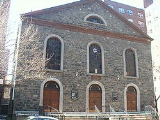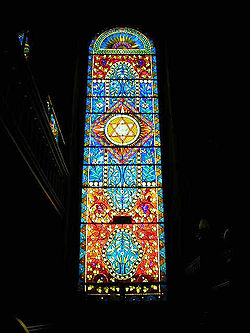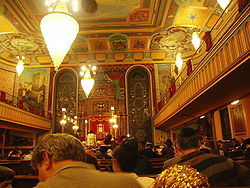
Bialystoker Synagogue
Encyclopedia


Lower East Side
The Lower East Side, LES, is a neighborhood in the southeastern part of the New York City borough of Manhattan. It is roughly bounded by Allen Street, East Houston Street, Essex Street, Canal Street, Eldridge Street, East Broadway, and Grand Street....
of Manhattan
Manhattan
Manhattan is the oldest and the most densely populated of the five boroughs of New York City. Located primarily on the island of Manhattan at the mouth of the Hudson River, the boundaries of the borough are identical to those of New York County, an original county of the state of New York...
, New York City
New York City
New York is the most populous city in the United States and the center of the New York Metropolitan Area, one of the most populous metropolitan areas in the world. New York exerts a significant impact upon global commerce, finance, media, art, fashion, research, technology, education, and...
, New York State is an Orthodox
Orthodox Judaism
Orthodox Judaism , is the approach to Judaism which adheres to the traditional interpretation and application of the laws and ethics of the Torah as legislated in the Talmudic texts by the Sanhedrin and subsequently developed and applied by the later authorities known as the Gaonim, Rishonim, and...
Jewish synagogue
Synagogue
A synagogue is a Jewish house of prayer. This use of the Greek term synagogue originates in the Septuagint where it sometimes translates the Hebrew word for assembly, kahal...
. The physical building is registered as an historic landmark.
History
The Bialystoker Synagogue was first organized in 1865 on Manhattan's Lower East SideLower East Side
The Lower East Side, LES, is a neighborhood in the southeastern part of the New York City borough of Manhattan. It is roughly bounded by Allen Street, East Houston Street, Essex Street, Canal Street, Eldridge Street, East Broadway, and Grand Street....
as the Chevra Anshei Chesed of Bialystok, founded by a group of Jews who came from town of Białystok in Poland
Poland
Poland , officially the Republic of Poland , is a country in Central Europe bordered by Germany to the west; the Czech Republic and Slovakia to the south; Ukraine, Belarus and Lithuania to the east; and the Baltic Sea and Kaliningrad Oblast, a Russian exclave, to the north...
. The congregation was begun in a building on Hester Street, then it later moved to Orchard Street
Orchard Street (Manhattan)
Orchard Street is a street in Manhattan which covers the eight city blocks between Division Street in Chinatown and East Houston Street on the Lower East Side...
, and ultimately to its present location 7-11 Bialystoker Place on the Lower East Side.
In order to accommodate the influx of new immigrants from that area of Poland, in 1905 the congregation merged with congregation Hadas Yeshuan, also from Bialystok, and formed the Bait Ha'Knesset Anshi Bialystok (The Bialystoker Synagogue). The newly formed congregation then purchased and moved into the Willett Street Methodist Episcopal Church at 7 Willet Street (now 7-11 Willet Street, later renamed Bialystoker Place). During the Great Depression
Great Depression
The Great Depression was a severe worldwide economic depression in the decade preceding World War II. The timing of the Great Depression varied across nations, but in most countries it started in about 1929 and lasted until the late 1930s or early 1940s...
a decision was made to beautify the main sanctuary, to provide a sense of hope and inspiration to the community.
Architecture
The fieldstone Methodist Episcopal ChurchMethodist Episcopal Church
The Methodist Episcopal Church, sometimes referred to as the M.E. Church, was a development of the first expression of Methodism in the United States. It officially began at the Baltimore Christmas Conference in 1784, with Francis Asbury and Thomas Coke as the first bishops. Through a series of...
building was built in 1826 with a simple pediment
Pediment
A pediment is a classical architectural element consisting of the triangular section found above the horizontal structure , typically supported by columns. The gable end of the pediment is surrounded by the cornice moulding...
ed roof and round arched windows. Later, William H. Boole
William H. Boole
William H. Boole was the pastor of the Willet Street Methodist Church in the Bowery in New York City. He ran in the 1882 New York gubernatorial election with the Prohibition Party.-Biography:...
was the church's pastor. The building is made of Manhattan schist
Manhattan schist
The Manhattan schist is a formation of mica schist rock that underlies much of the island of Manhattan in New York City. It is well suited for the foundations of tall buildings, and the two large concentrations of skyscrapers on the island occur in locations where the formation is close to the...
from a quarry on nearby Pitt Street. The exterior is marked by three windows over three doors framed with round arches, a low flight of brownstone steps, a low pitched pediment roof with a lunette window and a wooden cornice.
The elaborate Torah Ark is believed to have been carved in Bialystok
Bialystok
Białystok is the largest city in northeastern Poland and the capital of the Podlaskie Voivodeship. Located on the Podlaskie Plain on the banks of the Biała River, Białystok ranks second in terms of population density, eleventh in population, and thirteenth in area, of the cities of Poland...
and shipped to New York.
The synagogue was listed as a New York City Landmark on April 19, 1966. It is one of only four early-19th century fieldstone religious buildings surviving from the late Federal period in Lower Manhattan. Richard McBee and Dodi-Lee Hecht have both written in-depth articles about the building.
As the synagogue is home to an Orthodox Jewish congregation, a balcony section was constructed to accommodate female congregants. In the corner of the women’s gallery a small hidden door in the wall that leads to a ladder going up to an attic, lit by two windows was constructed. When it was first opened, the building was a rest stop for the Underground Railroad
Underground Railroad
The Underground Railroad was an informal network of secret routes and safe houses used by 19th-century black slaves in the United States to escape to free states and Canada with the aid of abolitionists and allies who were sympathetic to their cause. The term is also applied to the abolitionists,...
movement; runaway slaves found sanctuary in this attic.
When the air conditioning
Air conditioning
An air conditioner is a home appliance, system, or mechanism designed to dehumidify and extract heat from an area. The cooling is done using a simple refrigeration cycle...
was updated in the 1990s, an issue arose in the construction of rooftop units because of the building's historical landmark status. Because of these concerns, the cooling units were installed on the side of the building.
Present activity
In 1988 the congregation restored the interior to its original splendor, and the former Hebrew school building that is attached, but had become dilapidated, was renovated and reopened as The Daniel Potkorony Building. The magnificent stained glass windows were recently completely recreated and renewed.See also
- Kossar's Bialystoker Kuchen BakeryKossar's BialysKossar's Bialys on the Lower East Side, Manhattan is the oldest bialy bakery in the United States.-Background:...
- Bugsy Siegel Cultural References

